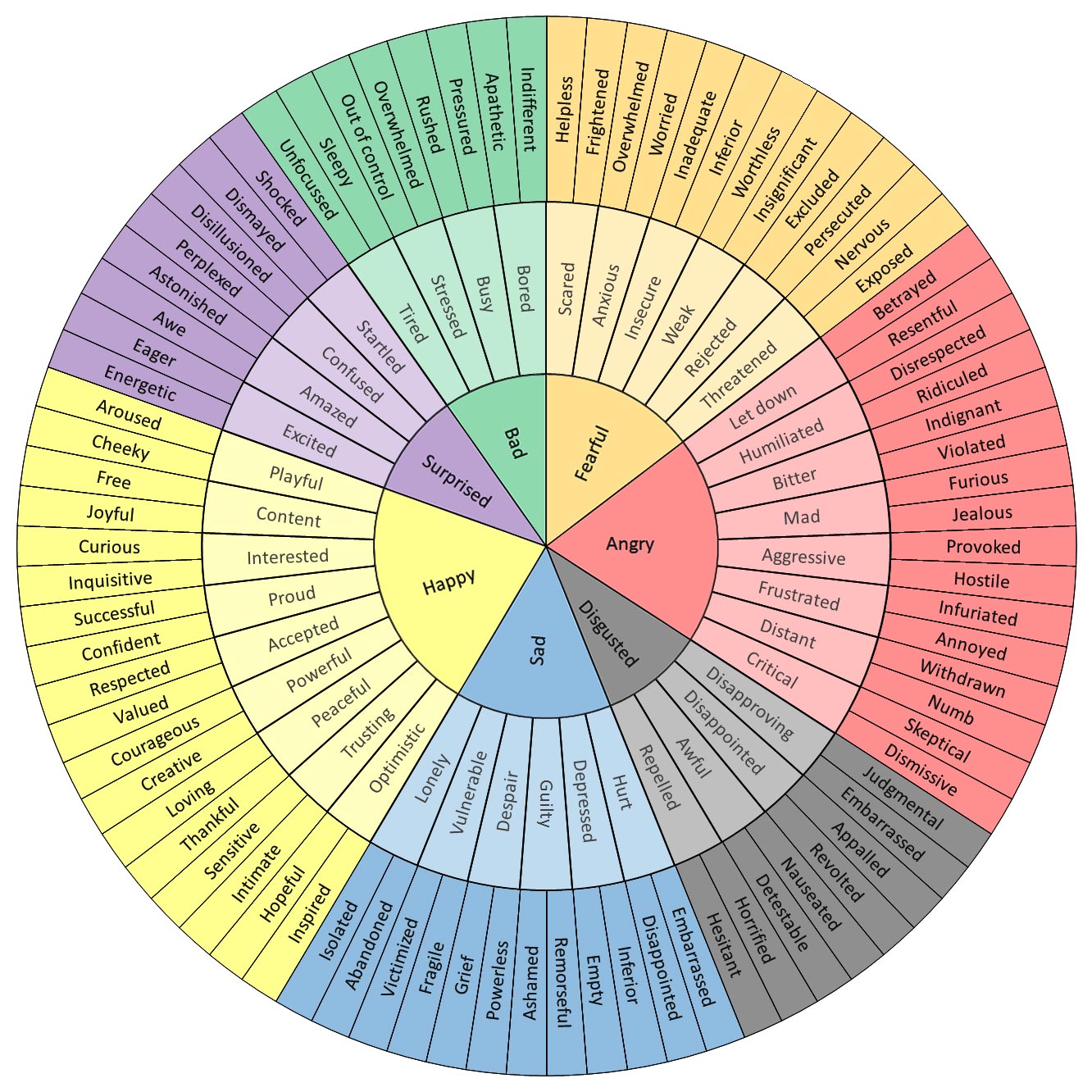Article from Issue #49 (September 7, 2022)
The Ultimate Guide to Understanding Your Emotions
by Mindwell NYC

Source: Mindwell NYC
Understanding feelings and emotions can be a difficult journey, even when you know how to do it.
In this article we will help you navigate the path of understanding feelings and emotions and how they affect your life.
In this article we will discuss:
- Step 1: The Role Emotions Play
- Step 2: Don’t Judge Your Emotions
- Step 3: What Each Emotion Feels Like & What They Are Trying To Tell You
- Step 4: Record Your Thoughts and Emotions
- Step 5: Expand Your Emotional Vocabulary
- Step 6: Share Your Emotions
- Step 7: See a Therapist
Let’s get to it!
Step 1: The Role Emotions Play
Emotional awareness is the ability to identify and understand your feelings and emotions. One of the most important determinants in how you relate to yourself and others is your level of emotional awareness. It impacts every part of your life, from how you feel, the choices you make and what you do to manage your stress levels.
People who are emotionally aware are better able to listen to others and understand their feelings (this is empathizing). They’re also more comfortable with intimacy because they know what it feels like to be open about their own feelings.
People who are more in tune with understanding feelings and emotions also have a healthier self-image and are less likely to be emotionally upset when something goes wrong.
Being able to identify what you are feeling at any given time enables you to make decisions about how best to proceed. You can decide whether to take action or do nothing, but at least you will have a better understanding of what your options are.
In addition, identifying your emotions accurately helps you sort out the important from the trivial. You learn to trust your instincts and not ignore what’s going on inside of you.
Step 2: Don’t Judge Your Emotions
The first step in understanding your feelings and emotions is to learn how to accept them without judgment.
This can be difficult because many of us have been taught that it’s not OK to feel certain emotions, such as anger or sadness.
However, all emotions are useful and important. Crying for example, is a natural way of letting go of pent up emotions and releasing stress. Not only this but crying actually releases neurotransmitters (like oxytocin & endorphins) that will help push you back to more positive emotions.
Being emotionally aware does not mean dwelling on your feelings, discussing them all the time, or even acting on them, but simply acknowledging, accepting, and processing them as they arise.
Feelings that are not expressed or understood can be very destructive over long periods of time. They can lead to stress and anxiety, as well as health problems including heart disease, insomnia, headaches and digestive disorders. Unresolved grief can lead to what is known as complicated grief which is much more painful and difficult to process than the original pain.
When we hold back our emotions, they become disassociated from us and out of our control. By bringing them into consciousness, we can identify them and direct our behavior more effectively.
Try to let go of the judgments you have about your feelings, and accept them as merely a part of being human. Only then can you begin the process of learning how to manage them in a healthy way.
Step 3: What Each Emotion Feels Like & What They are Trying To Tell You
In some situations, you might have difficulty naming what you’re feeling. This may happen if you’re feeling overwhelmed by some strong feelings, such as grief or sadness.
In this case, it helps to pay attention to how your body is reacting and what thoughts are going through your mind. By naming these reactions, you can begin to identify the emotion that’s causing them. It might help to ask yourself:
- What is my body telling me? If you’re overwhelmed and don’t know how you feel, pay attention to what your body is doing: Are your shoulders tense? Is there a knot in the pit of your stomach? Are you clenching your jaw or fists without even realizing it?
- How is my mind telling me I’m feeling? You may experience thoughts such as: “I feel like something bad is about to happen” or “This situation isn’t fair” Pay attention to these thoughts and see if they help you identify how you’re feeling.
- Next, ask yourself, “What are my emotions trying to tell me?” Every emotion has a message for you, if you take the time to learn what it is. When you become aware of a feeling or emotion, take a step back and try to understand what it means.
It is also possible to experience more than one emotion at once.
For example, you might simultaneously feel anger and hurt, or guilt and embarrassment. When this happens, try to deal with each feeling separately. When your feelings are clear, it’s easier to use the appropriate coping strategies that will diffuse their negative effects.
The Voice Of Anger
During anger you might realize that your heart is beating faster than usual, you’re breathing faster and maybe shaking a little bit. Your face and neck may feel hot and your fists might clench. When we become angry it’s common for us to want to yell, throw things, and even lash out at the other person.
You may experience thoughts such as “I hate him” or “I can’t believe she did that”; “This is ridiculous” or “This isn’t fair!”; strong feelings of hostility; the impulse to blame others for your problems; difficulty concentrating, and/or thoughts about revenge.
Anger is an intense feeling or emotion that can be triggered by a negative event or interaction. Anger tells you to take some sort of action—positive or negative. It can lead to aggression, since your body is readying itself for some sort of physical retaliation.
Anger can tell us that something is wrong and needs attention. Anger may also signal that something feels unfair–for example, you might feel angry if you’re passed over for a promotion at work despite the fact that you have the best numbers in the office.
You may need to set appropriate boundaries, or learn how to express anger in ways that don’t hurt yourself and others, such as learning to say “no” or taking time to cool down. If you struggle with anger, take some time to learn more about blaming, shaming, and controlling statements. Do your best to communicate in a healthy way, even when it feels like anger is getting the best of you. Anger can be a good thing if we let it help motivate us to change our circumstances or behaviors for the better.
To learn more about how to respond when you’re feeling angry, check out our blog: How To Stay Calm Around Those Who Push Your Buttons
The Voice Of Sadness
When we feel sad we may experience a heaviness in the heart and chest, and become tearful and more likely to feel the need to withdraw from people. Sadness can make us feel lethargic and we might not be able to concentrate very well on anything other than our pain.
When people feel sadness or grief they often experience strong feelings of emptiness or despair; thoughts such as “this pain will never go away” or “I’m all alone”; the impulse to withdraw, sleep or cry; difficulty concentrating, and/or thoughts about wanting to avoid life.
Sadness is a feeling that can be triggered by many events such as loss of someone close, loss of a job, and even the break up of a relationship.
The feeling of sadness often tells us that something is missing in our lives or that some loss or disappointment has occurred. Sadness signals a need for comfort and support. It could mean that we need to take care of ourselves and allow ourselves time to heal.
To learn specifically about depression and how to overcome it check out our blog: 5 Most Powerful Strategies To Beat Depression In 2022
The Voice Of Fear
When you’re feeling scared, your heart might beat fast and hard, you might begin to sweat a little bit, feel short of breath or hyperventilate. You may become tense throughout your whole body or even shake all over. You may have a pit in your stomach or a sense of dread about what’s going to happen next.
If you’re faced with a threat, your body will prepare to either fight or flee. When we are afraid, it’s common for us to feel on edge and have trouble concentrating or thinking clearly. You might have thoughts like “I’m going to faint,” or “Get me out of here! I want to run!”
Fear is one of the most basic and primal emotions we have as humans. Fear is an emotional response to a perceivable threat of danger, pain, or harm. When someone feels a sense of fear it is usually a survival instinct to help them avoid a dangerous situation or at least be aware of the potential danger around them.
Fear tells you to run! While fear is a response to a present threat, anxiety is a feeling that is often triggered by the fear of something bad happening in the future. Anxiety is often experienced even though there is no real threat, only a perceived one. Anxiety may mean it’s time to regain some sense of control over your emotions or situation. It may also mean you need to let go of things that are not within your control.
The Voice Of Surprise
When you’re surprised your heart speeds up and you may feel wide awake, dizzy and lightheaded. You may experience a jolt of energy throughout the body. You might feel frozen in place or overwhelmed. You might have thoughts like “I’m not sure what to do,” or “I don’t know how to react.”
Surprise is a feeling that can be triggered by shocking or unexpected events/interactions. Feeling surprised is usually rooted in the feeling of being caught off guard.
It can also be rooted in the feeling of neutral or positive things unexpectedly happening such as receiving a compliment or getting a promotion at work. Surprise tells you that it’s time to slow down and process information, since something unexpected has happened.
The Voice Of Disgust
When you are disgusted your heart may beat faster or slower than usual. You may feel nauseated or sick to your stomach, as if you want to throw up. You might have thoughts like “That’s so gross!” or “How could someone do that?”
Disgust is usually triggered by something that is considered unpleasant, offensive, or immoral. This emotion is rooted in the idea of avoiding harmful substances, like rotten food or toxic chemicals. Disgust is telling you to push the repulsive thing away from you for your own safety.
The Voice Of Happiness
Happiness is usually triggered by positive events or interactions that make you feel good. When you are happy you may experience a feeling of contentment and joy. Sometimes happiness can be triggered by the smallest thing like a compliment or finishing an assignment on time.
Happiness cues you into things that are important to you, such as having positive relationships with others, gaining new skills or abilities, and feeling like you belong.
The Voices Of Guilt & Shame
Guilt is a feeling about an individual action one has committed. When you feel guilty it feels like a sharp pain in your heart, and you may find yourself wanting to make amends with the person you hurt. Guilt is a result of doing something that violates your own personal moral code or rules. When people feel guilt, they often have thoughts such as “I did something bad,” or “I should have done something differently.”
Shame, on the other hand, can feel like a heavy weight bearing down on your shoulders, and you may feel the need to hide from others. Shame is a negative feeling that focuses on the self. The “self” is who you are as a person. We feel shame when we think that who we are as a person is flawed and defective. When people feel shame, they have thoughts such as “I’m bad,” or “I’m worthless.”
Shame can have a corrosive effect on your self-esteem and sense of identity. When shame goes unattended in our life, it often makes us feel insecure, unloved and lonely. It is pushing away friends and family who could otherwise be supportive.
Guilt, on the other hand, signals that what we did may have been wrong, but who we are as a person is not wrong. It can help us realize that our behavior has hurt someone or broken an important relationship, and may provide the impetus we need to apologize and reconcile.
If you want to learn more about dealing with shame, check out our article: How To Move Through Shame By Getting In Touch With Your Creative Side.
Step 4: Record Your Thoughts and Emotions
You can practice listening and understanding feelings and emotions that you experience by getting into the habit of recording your emotions on a daily basis, every time you feel something new or different. This will help you identify your patterns and give you an insight into how you are feeling over time.
Ask yourself: What is making me feel this way? If you’re feeling anxious, what is causing it? Is there a difficult task looming in your future that might lead to performance anxiety? If you’re feeling sad, why are you feeling that way? Are you watching a movie or show that’s eliciting the emotion for you? What happened earlier today that might have caused the feeling?
Take a closer look at each situation and identify what’s triggering those feelings. Once you can recognize your triggers, you’ll be better prepared to avoid future negative feelings, or at least learn how to cope with them more effectively.
Negative thoughts can also play an important role in shaping emotions, and in many cases they actually create the feelings we experience in response to them.
For example: If you think “I can’t,” or “I’ll never be able to do this,” you might end up feeling anxious, overwhelmed, and stressed out. However, when you replace those thoughts with something like, “This is really challenging, but I’m prepared to give it my all,” you might end up feeling more confident and in control.
To learn more about the negative thinking that could be affecting your emotions, check out the post on cognitive distortions → HERE
Identify the thoughts that are directly related to the emotions you’re feeling. If you want to challenge negative thinking, try writing down some alternative, more positive thoughts about a situation, and seeing how it changes your mood.
Step 5: Expand Your Emotional Vocabulary
It can be helpful to develop a larger vocabulary for understanding feelings and emotions. Creating a list of feeling words and putting them in order from least distressing to most distressing can help you identify your feeling and therefore what you need.
Suppose you are feeling angry, you might ask yourself if you are “a little annoyed,” “irritated”, “furious” or even “enraged.” The word that you choose can help you identify your starting point and the intensity of your emotion.
Then you can plan accordingly and take steps toward resolving or managing your feelings. The right words paint a clearer picture of what you’re going through and help you better express those feelings to others.
To improve your emotional vocabulary, check out emotions list → HERE
Step 6: Share Your Feelings
The most common way many people release negative feelings is by talking about them or sharing them with someone they trust. You don’t have to go into great detail, just voicing out loud the thoughts that are troubling you will help dissipate some of their intensity and make it easier to gain a broader perspective.
Talking and understanding feelings and emotions is also one of the best ways to sort them out. Often, when we are angry or afraid, the problem seems bigger than it really is. By talking things over with someone who listens without judging us or becoming defensive, we can gain insight into how to resolve the situation effectively.
Step 7: See a therapist
If you feel like not understanding feelings and emotions are starting to interfere with activities such as work, school or relationships, it may be time to talk with someone who is trained to help you work through your feelings in an orderly way.
Therapists can help you understand how specific thoughts, physical sensations, behaviors, and past experiences work together to create feelings of anxiety, shame, etc. They can also teach you strategies for “grounding” yourself when you start to feel overwhelmed.
That brings us to the end of this post on understanding feelings and emotions.


 What is Chromotherapy? Using the Frequency of Color to Heal the Body
What is Chromotherapy? Using the Frequency of Color to Heal the Body Loss in a Time of Uncertainty
Loss in a Time of Uncertainty Binaural Beats Therapy: Benefits and How they Work
Binaural Beats Therapy: Benefits and How they Work